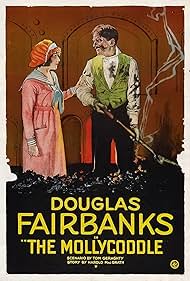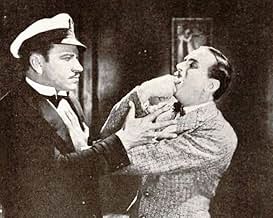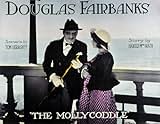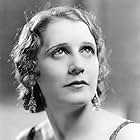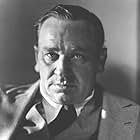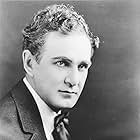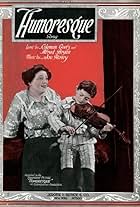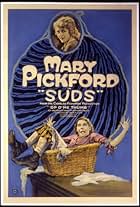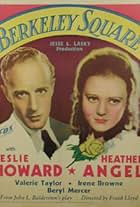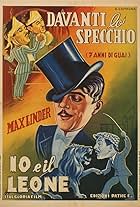VALUTAZIONE IMDb
6,5/10
219
LA TUA VALUTAZIONE
Aggiungi una trama nella tua linguaAn American who has lived much of his life outside the country returns to Arizona for the first time in years and encounters villainy.An American who has lived much of his life outside the country returns to Arizona for the first time in years and encounters villainy.An American who has lived much of his life outside the country returns to Arizona for the first time in years and encounters villainy.
Frank Campeau
- Man at Trading Post
- (non citato nei titoli originali)
Bull Montana
- Fish Cannery Worker
- (non citato nei titoli originali)
Trama
Lo sapevi?
- QuizThis was one of the few films in which Douglas Fairbanks did not perform most of his own stunts. Shortly after filming began he badly hurt his wrists while attempting a running mount of a horse; the animal got spooked and took off just as he was jumping on her. Veteran stuntman Richard Talmadge, who had previously doubled for Fairbanks in other films for stunts that the studio deemed too dangerous for him to perform, was hired as Fairbanks' stunt double for most of the stunts in this film.
- BlooperAt about 5:54 into the film, Richard Marshall IV throws well-worn Barber half dollars at the feet of townspeople imploring them to celebrate a newlywed couple. Minutes earlier, a title card identified the year as 1880. The Barber half dollar was first introduced into American coinage in 1892, twelve years after the scene depicted. The most likely half dollar he should have thrown was the Liberty-seated type.
- Curiosità sui crediti"FOREWORD: Our thanks are gratefully expressed to government officials, tribal chiefs, and to the hundreds of picturesque Hopi Indians on their reservation near the Painted Desert of Arizona, who, in their savage way heartily welcomed us to their prehistoric villages and with primitive cheerfulness played an important part in this picture."
- ConnessioniFeatured in Douglas Fairbanks: Je suis une légende (2018)
Recensione in evidenza
Douglas Fairbanks is one of those legendary figures of cinema. Even today, seventy years after his death, his name is still vaguely alive in the public consciousness. Naturally he is remembered mainly for the series of extraordinary swashbuckling adventures he appeared in throughout the 1920s. It is less well known that he started his screen career in comedy, and it was as a comic that he made his name. The Mollycoddle is among his last comedy pictures, and also among the better ones.
Fairbanks's comedies were not a million miles from his swashbucklers. His comic niche was always the combination of humour with breathtaking athleticism. The Mollycoddle is particularly reminiscent of the adventure flicks, because like Zorro, Robin Hood and the Thief of Bagdad, the character goes through an arc of self-discovery whereby he finds his he-man persona. The aim of The Mollycoddle is still clearly as much to thrill as it is to get laughs. And the rather oddball sense of Fairbanks humour would carry through into his later pictures, although it's only pictures like this that we see it in its fully unbridled state, a cracking example being the foreigner's conception of America as cowboys shooting each other up amidst skyscrapers.
You see, as well as possessing an impressive physique, Fairbanks was a genuine funny-bones comedian. You can tell he is having great fun portraying the idle twerp that his character begins as, hamming up the stereotype for all it is worth. Even when the eponymous Mollycoddle starts to grow a bit of backbone, Fairbanks is sensible enough (and a good enough comic) to keep something of the twit about him, blending action with gags as he later would in his swashbucklers.
A notable fact about the Mollycoddle is that it happens to be the directorial debut of one Victor Fleming, of Gone with the Wind and the Wizard of Oz fame. Fleming was a pal of Fairbanks, both of them being rough and rugged outdoorsmen, and the star liked to have someone he could relate behind the camera. The young director shows his lack of experience, with some of the busier shot compositions being a bit haphazard, but what he lacks in finesse he makes up for in intention. A former racing driver, he was a man in love with speed, and he keeps up a solid pace in action sequences, often with continuous movement in each shot. Here and there he grabs our attention by having a key movement go towards the camera.
It's perhaps tempting to look for failings in Fairbanks's comedies, as if we might find some clue as to why his career changed direction. But the truth is, while none of his comedies is on a par with the best of his adventures, there is nothing really wrong with them. They were hugely successful in their day, and Fairbanks was a big star even before he began sporting capes and rapiers. It appears that making swashbucklers was simply something he wanted to do, or even something he felt was the next logical step. The Mollycoddle is in that sense a missing (or at least widely forgotten) link, showing us how Doug the swashbuckler was the natural extension of Doug the comic.
Fairbanks's comedies were not a million miles from his swashbucklers. His comic niche was always the combination of humour with breathtaking athleticism. The Mollycoddle is particularly reminiscent of the adventure flicks, because like Zorro, Robin Hood and the Thief of Bagdad, the character goes through an arc of self-discovery whereby he finds his he-man persona. The aim of The Mollycoddle is still clearly as much to thrill as it is to get laughs. And the rather oddball sense of Fairbanks humour would carry through into his later pictures, although it's only pictures like this that we see it in its fully unbridled state, a cracking example being the foreigner's conception of America as cowboys shooting each other up amidst skyscrapers.
You see, as well as possessing an impressive physique, Fairbanks was a genuine funny-bones comedian. You can tell he is having great fun portraying the idle twerp that his character begins as, hamming up the stereotype for all it is worth. Even when the eponymous Mollycoddle starts to grow a bit of backbone, Fairbanks is sensible enough (and a good enough comic) to keep something of the twit about him, blending action with gags as he later would in his swashbucklers.
A notable fact about the Mollycoddle is that it happens to be the directorial debut of one Victor Fleming, of Gone with the Wind and the Wizard of Oz fame. Fleming was a pal of Fairbanks, both of them being rough and rugged outdoorsmen, and the star liked to have someone he could relate behind the camera. The young director shows his lack of experience, with some of the busier shot compositions being a bit haphazard, but what he lacks in finesse he makes up for in intention. A former racing driver, he was a man in love with speed, and he keeps up a solid pace in action sequences, often with continuous movement in each shot. Here and there he grabs our attention by having a key movement go towards the camera.
It's perhaps tempting to look for failings in Fairbanks's comedies, as if we might find some clue as to why his career changed direction. But the truth is, while none of his comedies is on a par with the best of his adventures, there is nothing really wrong with them. They were hugely successful in their day, and Fairbanks was a big star even before he began sporting capes and rapiers. It appears that making swashbucklers was simply something he wanted to do, or even something he felt was the next logical step. The Mollycoddle is in that sense a missing (or at least widely forgotten) link, showing us how Doug the swashbuckler was the natural extension of Doug the comic.
I più visti
Accedi per valutare e creare un elenco di titoli salvati per ottenere consigli personalizzati
Dettagli
- Tempo di esecuzione1 ora 26 minuti
- Mix di suoni
- Proporzioni
- 1.33 : 1
Contribuisci a questa pagina
Suggerisci una modifica o aggiungi i contenuti mancanti

Divario superiore
By what name was Un pulcino nella stoppa (1920) officially released in Canada in English?
Rispondi